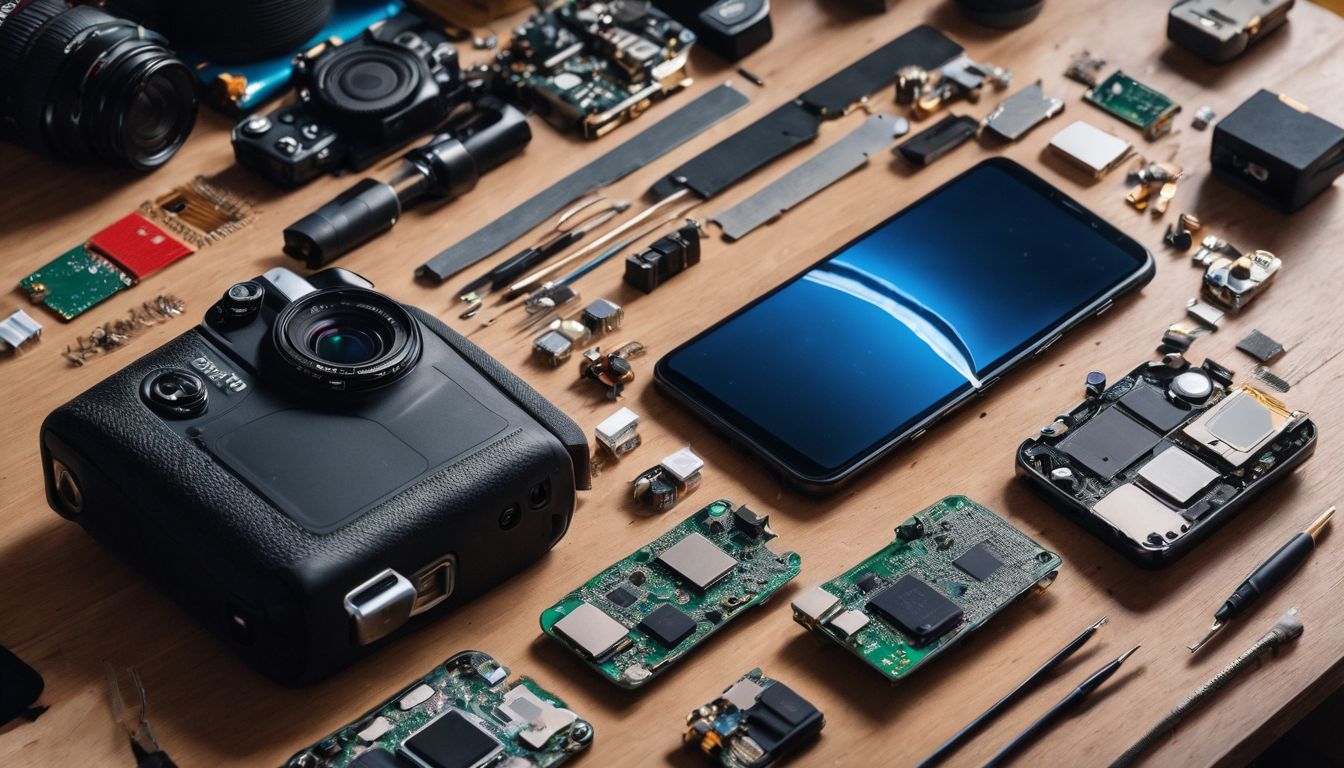Have you ever spared a thought for the journey of your cherished face scrub once it takes that spiral voyage down the plughole? It’s a question that’s been niggling at our minds too, and as it turns out, our oceans might be quietly bearing the brunt.
The microplastics that lurk in our beauty products are making waves in marine life more than we realised, and this piece is set to delve into why those unassuming specks could herald vast trouble for our blue planet.
So join us as we navigate through this ocean of revelations – together we can chart a course towards cleaner seas!
Key Takeaways
- Microplastics, often used in exfoliating cosmetics like face scrubs, are tiny pieces of plastic that slip through water filtration systems and end up polluting the oceans.
- These microbeads can be ingested by marine animals, causing blockages and potentially entering the human food chain via seafood consumption, which may pose health risks.
- Campaigns worldwide are advocating for a ban on microplastics in personal care products due to their environmental impact and threat to marine ecosystems.
- Consumers can help combat this issue by choosing skincare products with natural exfoliants such as sugar or salt and supporting brands committed to sustainability.
- Proper disposal of cosmetic products is also crucial; look out for specific instructions on packaging or local recycling programs to prevent further pollution.
What are Microplastics and How Are They Used in Cosmetics?
Microplastics are tiny particles of plastic that are commonly used in exfoliating products, such as facial scrubs and body washes. These tiny particles have the ability to remove dead skin cells, leaving the skin feeling smooth and refreshed.
Definition of microplastics
Microplastics are tiny plastic pieces, no more than five millimetres in length, that can wreak havoc on marine environments. Often found in our face scrubs and shower gels, these small culprits serve as exfoliating agents to buff away dead skin.
But their size deceives; despite being minuscule, they pose a monumental threat to ocean ecosystems and the creatures within.
We’ve seen how these microbeads from personal care products slip through water filtration systems and end up floating in our seas. Once there, they contribute to the growing issue of plastic pollution – an enemy we’re all fighting against for cleaner oceans and healthier marine life.
Commonly used in exfoliating products
Skincare products often contain microplastics, particularly in exfoliating products that aim to remove dry, dead skin cells. These minute plastic particles, also known as microbeads, serve as exfoliating agents within cosmetics and personal care items.
By adding these tiny plastic spheres to the formulations of various skincare products, manufacturers enhance the exfoliating properties and make them effective in removing dry skin.
However, this widespread usage of microplastics poses a significant threat to our oceans due to its contribution to plastic pollution.
Furthermore, these microbeads are one of the primary sources of environmental microplastics. Due to their small size (less than five millimetres), they pose a challenge for cleaning up once they enter aquatic environments.
Ability to remove dead skin cells
Microplastics have the ability to remove dead skin cells, commonly used in exfoliating products. These small plastic pieces, less than five millimeters long, add exfoliating properties to skincare products, helping to slough off dry, dead skin cells.
However, their presence poses a threat to plastic pollution and endangered oceans as personal care and cosmetic products containing microbeads are a primary source of environmental microplastics.
The use of microplastics in cosmetics is a cause for concern due to its contribution to the larger issue of plastic pollution. Efforts are underway globally to address this challenge and find sustainable alternatives that reduce environmental impact while providing effective skincare solutions.
The Dangers of Microplastics in Cosmetics
Microplastics in cosmetics pose a significant threat to marine life, as they can be ingested by animals and enter the food chain. Additionally, their presence in our oceans contributes to environmental pollution and poses potential health risks for humans.
Harmful effects on marine life
Microplastics threaten marine life, endangering our ocean ecosystems. These tiny plastic particles, less than five millimeters long, are often mistaken for food by sea creatures and can lead to blockages in their digestive systems or cause internal damage.
Furthermore, the chemicals that these microplastics absorb from the surrounding water may have adverse effects on aquatic organisms’ health and reproductive capabilities.
The pollution caused by microplastics disrupts marine habitats and food chains, impacting entire ecosystems. Marine life at all levels is vulnerable to the harmful effects of microplastic pollution, from small fish ingesting them to larger predators consuming contaminated prey.
Ability to enter the food chain
Microplastics, found in various personal care products, have the potential to enter the food chain and pose a threat to marine ecosystems. These tiny plastic particles, less than five millimeters long, can be ingested by aquatic organisms such as fish and shellfish.
As a result, microplastics accumulate in these organisms’ bodies and may eventually be consumed by humans through seafood consumption. This highlights the concerning link between microplastic pollution in oceans and its impact on our food sources.
Adding to this concern is the fact that ongoing research is investigating the potential health risks associated with consuming seafood contaminated with microplastics. Efforts to address this issue include calls for bans on the use of microplastics in cosmetics and personal care products, aiming to mitigate their entry into the food chain and safeguard both marine life and human health.
Threat to our health
Cosmetic products containing microplastics pose a threat to our health due to the potential risks of these tiny plastic particles entering our bodies. These microplastics, commonly used as exfoliating agents in skincare and personal care items, have been found to be harmful when they make their way into the food chain.
Research suggests that these minute plastic fragments may carry toxic chemicals that could potentially impact human health when ingested. With concerns about the long-term effects on human well-being, there is an increasing need for further investigation into the potential health risks associated with exposure to microplastics in cosmetics.
Our health is at risk from these imperceptible plastic entities since they can introduce harmful substances into our systems through various cosmetic and personal care products. It’s essential for consumers to understand this hazard and take steps towards avoiding such microplastic-containing items where possible.
The Worldwide Movement Against Microplastics in Cosmetics
Environmental concerns have led to campaigns against the use of microplastics in cosmetics, with consumers playing a crucial role in demanding sustainable and eco-friendly products.
To learn more about the impact of microplastics in cosmetics and how you can make a difference, keep reading.
Environmental concerns
Microplastics in cosmetics have raised significant environmental concerns due to their detrimental impact on marine life and ocean pollution. With microplastics being a primary source of plastic pollution in the oceans, it’s vital to address the threat they pose to our delicate ecosystems.
These tiny plastic particles can be mistaken as food by marine organisms, leading to bioaccumulation and potential harm to human health when consumed through the food chain. Efforts are underway worldwide to combat this issue, with calls for bans on microplastics in cosmetic products and campaigns promoting clean seas and sustainable alternatives gaining momentum.
Plastic waste from personal care products containing microbeads contributes significantly to the increasing levels of marine pollution, which poses a grave danger to aquatic life. The ongoing concern about the environmental damage caused by microplastics necessitates a collective effort from consumers, manufacturers, and policymakers alike in supporting initiatives aimed at reducing plastic waste in our oceans.
Campaigns against plastic in cosmetics
The role of consumers
Campaigns against plastic in cosmetics have brought the issue of microplastics to the forefront, prompting consumers to take action. Our choices as consumers directly impact the demand for products containing microplastics.
By being informed and selective about the skincare and cosmetic products we purchase, we can drive change in the industry and encourage brands to develop more sustainable alternatives.
Reading ingredient labels with vigilance and opting for natural exfoliants can make a significant difference in reducing our contribution to microplastic pollution. Additionally, supporting brands that prioritise environmental responsibility and ethical sourcing can help promote a shift towards eco-friendly practices within the beauty industry.
Myths and Realities About Microplastics in Cosmetics
Many people believe all microplastics in cosmetics are harmful, but not all polymers used are damaging to the environment. It is important to distinguish between different types and understand the need for further research in this area.
Distinguishing between different types of polymers
Microplastics in cosmetics can come in various forms, including polyethylene, polypropylene, and polystyrene. It’s essential to recognise these different types of polymers because they each have unique properties that affect their environmental impact.
Polyethylene is the most common type found in exfoliating products and is known for its ability to remove dead skin cells. Polypropylene is often used in makeup as it helps create a smooth texture, while polystyrene provides durability to certain cosmetic items.
Understanding the various types of polymers allows consumers to make informed choices when selecting cosmetic products and supports efforts towards reducing microplastic pollution.
Fact vs. fiction about the use of microplastics in cosmetics
Microplastics in cosmetics are a contentious subject, often surrounded by myths and misinformation. It’s crucial to distinguish between different types of polymers used in cosmetic products to separate fact from fiction.
Contrary to popular belief, not all microplastics pose an equal risk to the environment and human health. There is a need for more extensive research and accurate information dissemination regarding the use of microplastics in cosmetics.
It’s important to be aware that efforts are being made globally to address the issue of microplastics in cosmetics and personal care products. Advocacy groups, environmentalists, and concerned individuals are leading campaigns against plastic in cosmetics as they recognise the potential harm it poses to our oceans and marine life.
The need for more research
More research is essential to better understand the impact of microplastics in cosmetics on our health and the environment. Scientists are investigating how these tiny plastic particles affect marine life and whether they pose a risk to human health.
The findings will guide regulatory actions, ensuring that cosmetic products are safe for both consumers and the planet. As passionate gamers with a keen interest in environmental awareness, it’s crucial to support ongoing research efforts and stay informed about the latest developments in microplastics regulations.
Efforts towards banning microplastics from cosmetics continue to gain momentum as environmental awareness grows. It’s vital for novice gamers to recognise the significance of supporting sustainable brands and choosing skincare products without harmful microplastic ingredients.
How to Avoid Microplastics in Your Skincare Routine
To avoid using products with microplastics, opt for natural alternatives like sugar or salt scrubs. Read ingredient labels to identify any polymers and support sustainable brands that use biodegradable exfoliants.
Properly dispose of cosmetic products to prevent microplastics from entering the environment.
Choosing natural alternatives
When selecting skincare products, opt for natural alternatives instead of those containing microplastics. Look for exfoliating products with natural ingredients such as apricot kernels, oatmeal, or sugar to gently remove dead skin cells without harming the environment.
These options provide effective exfoliation while being biodegradable and eco-friendly. By prioritising natural alternatives, we can support sustainable brands that contribute to reducing plastic pollution in our oceans.
Supporting brands that offer environmentally friendly options is crucial in combating microplastic pollution in cosmetics. Taking the time to read ingredient labels and choose products free from microbeads helps protect marine life and contributes to a healthier planet overall.
Reading ingredient labels
When choosing skincare products, it’s essential to read ingredient labels carefully. Look out for terms like “polyethylene” and “microbeads,” as these indicate the presence of microplastics in the product.
Instead, opt for products with natural exfoliants such as apricot kernel powder or jojoba beads. By understanding and checking the ingredient labels, consumers can make informed choices that support sustainable practices and help reduce the impact of microplastics on our environment.
Understanding how to read ingredient labels empowers us to select cosmetic products that align with our values and contribute positively to environmental conservation efforts. Supporting brands that are committed to sustainability and avoiding those that use microplastics can drive positive change in the cosmetics industry.
Supporting sustainable brands
When choosing skincare products, look for sustainable brands that offer natural alternatives to microplastics. Opt for products made with biodegradable exfoliants like jojoba beads, rice powder, or ground apricot kernels instead of synthetic microbeads.
These sustainable brands prioritise eco-friendly ingredients and packaging, helping to reduce your impact on the environment while still maintaining a quality skincare routine. By supporting these brands, you can contribute to the preservation of our oceans and marine life by avoiding the use of harmful microplastics in your beauty regimen.
Proper disposal of cosmetic products
Proper disposal of cosmetic products is crucial to prevent them from ending up in landfills and bodies of water. When we finish using a cosmetic product, it’s important to check the packaging for any specific disposal instructions.
Additionally, we can look for recycling symbols or instructions on how to recycle the container. Remember, some products may need to be disposed of as hazardous waste due to their ingredients.
Once we’ve finished with a cosmetic product, we should avoid simply throwing it in the bin and instead consider if there are any local collection programmes or drop-off points that accept used beauty products.
Conclusion
In conclusion, the use of microplastics in cosmetics poses a significant threat to our oceans and marine life. Efforts are being made globally to raise awareness and push for bans on microplastic usage in personal care products.
It’s crucial for consumers to educate themselves, choose natural alternatives, and support sustainable brands to minimise the impact of microplastics on the environment. By taking these steps, we can work towards preserving our oceans for future generations.
FAQs
1. What are microplastics in cosmetics?
Microplastics in cosmetics refer to tiny plastic particles often used as exfoliating agents that can end up polluting our oceans.
2. Why are microplastics a problem for the ocean?
Microplastics pose a serious threat as they accumulate and harm marine life, contributing to the ongoing issue of ocean pollution.
3. Are there any alternatives to microplastics in cosmetic products?
Yes, many companies now use natural exfoliating materials like salt, sugar, or ground nutshells instead of microplastics.
4. Has there been a ban on microplastics in cosmetics?
Several countries have introduced regulations or bans on the use of microplastics in cosmetic products to protect the environment.





